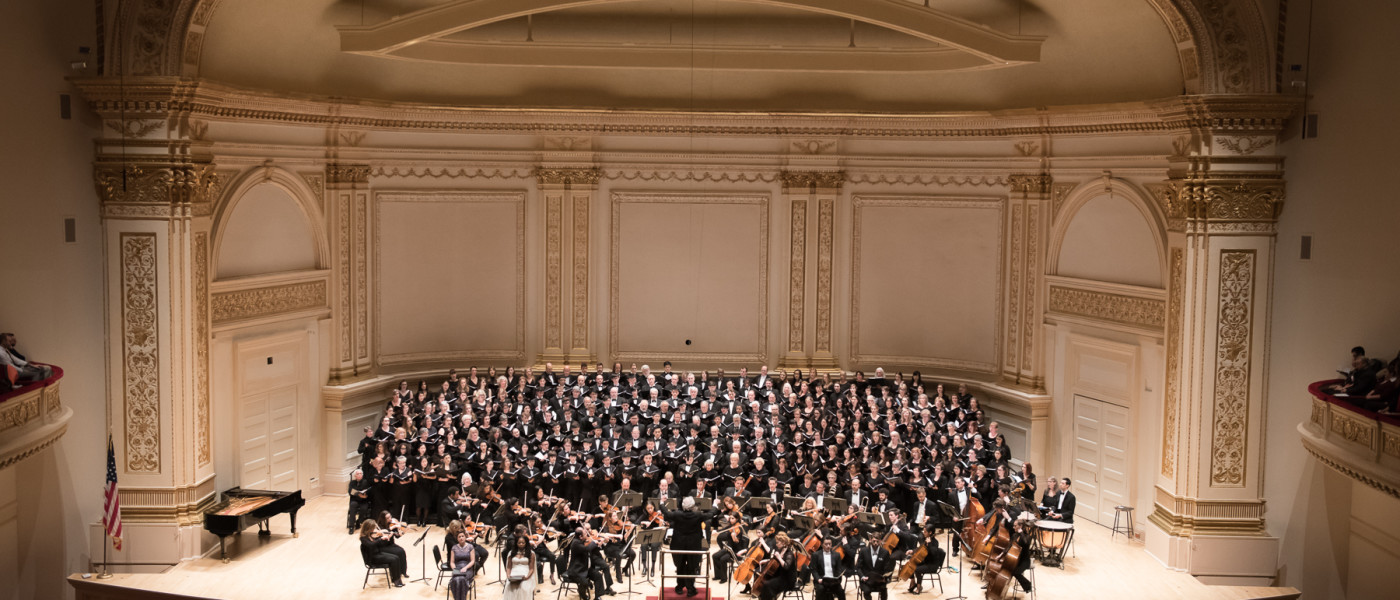Distinguished Concerts International New York (DCINY) presents Mozart Mealor Martin: Music of Joy and Sadness in Review
Distinguished Concerts International New York (DCINY) presents Mozart Mealor Martin: Music of Joy and Sadness
Distinguished Concerts Orchestra and Distinguished Concerts Singers International
Vance Y. George, James Jordan, and Joseph Martin, Conductors
Penelope Shumate, soprano; Krysty Swann, mezzo-soprano; Youngbae Yang, tenor; Jeremy Milner, bass-baritone
Stern Auditorium at Carnegie Hall, New York, NY
February 15, 2016
Distinguished Concerts International New York (DCINY) continued its record of inspirational massed-choral and orchestra concerts, “changing lives through the power of performance,” as their motto states. It is truly a credit to the many individual local choral conductors who prepared these groups that came from all over the US, UK, Austria, and New Zealand, and had but a short time to work out a polished interpretation with all the other choirs, orchestra, and the “real” conductor. It is good to see that these individual conductors are given their own bow(s) after their groups have performed.
The concert was presented in inverse order of its title, hence Martin, Mealor, Mozart. A rather long group of faith- and patriotic-based material, all composed by Joseph Martin (one Irving Berlin arrangement) and conducted by him, opened the program on a suitably upbeat note. If the music wasn’t surprisingly original, it certainly was very pleasing and accessible for community choirs. This particular group of over two hundred had a surprisingly difficult time making itself heard over the full orchestrations, when singing at or below mezzo-forte. When singing by themselves however, the full volume passages were appropriately thrilling, although diction was fuzzy.
Would it be churlish to mention that these mass-choir events require a great deal of stage management, moving one group of two hundred off the risers, moving the next group on, etc. and that this stretches the times of the programs quite a bit? Perhaps this process could be streamlined. And please credit the excellent orchestra by listing its players; they play beautifully. After a very long “brief pause” listed in the program, came the stunning success of the evening: Paul Mealor’s Stabat Mater.
Let me go out on a limb here and state that when I die, if there “is” a heaven, I want it to sound like the music of Paul Mealor. I, like millions across the world, first heard his music in the form of the delicious Ubi caritas that was sung at the 2011 royal wedding of Prince William and Kate Middleton. Mr. Mealor has a way of conveying a divine radiance with his harmonies—although firmly anchored in traditional tonality, his way with a “cluster” creates a sort of spiritual “smudge” (he even mentions incense as an aid to worship, a high Anglican tradition) that is incredibly mysterious and moving.
The Stabat Mater, a portrait of the sorrowful mother of Jesus at the foot of the cross, hits all the satisfying points one could wish, and does not remain mired only in the pain of the scene, but progresses to acceptance, hope, and faith. The work is dedicated to Mr. Mealor’s grandparents. The conductor for this work was James Jordan (disclaimer: an alumnus of one of my alma maters: Westminster Choir College). We also share many of the same mentors in choral conducting. Of course credentials are worthless unless put into practice, and wow, were they ever put into practice. His choir sang with an infinite variety of color and dynamic contrasts, razor sharp diction despite the size of the group, and great emotion. The soprano soloist, the excellent Penelope Shumate (doing double duty in the Mozart Requiem) soared above the choir with her descant, which seemed the embodiment of light. The audience, after a transcendent and respectful silence at the end, erupted into a well-deserved standing ovation. The ensemble remained on stage for the World Premiere of a short, boisterous work Jubilate Deo, also by Mr. Mealor.
After intermission, the Mozart Requiem was conducted by Vance George, with yet another choral assembly of about two hundred. Here, the size of the choir was truly a liability. George took some quite brisk tempi that are utterly justified in light of historically-informed performance practice, but that a large choir would have trouble rendering distinctly. Again, the orchestra seemed louder than the choir, quite an accomplishment. There were numerous discrepancies of ensemble, and one false start, discreetly and rapidly remedied. The four soloists did not benefit from being separated: the two men stage left, the ladies stage right. This creates an automatic deficit in the feeling for cooperation. Ms. Shumate was joined by a fabulous mezzo-soprano, new to me, Krysty Swann, whose plumy tone was natural, never forced, and whose musicality was beautiful. The men fared somewhat less well: tenor Youngbae Yang certainly sang all the notes without strain, but without obvious emotional connection; and the bass-baritone Jeremy Milner made a stereotypically wooly, dark sound, and was out of tune in his “big” moment, the first phrase of the Tuba mirum (miraculous trumpet), which was fully a half-step too high by the end, while the trombone which symbolizes this summoning miracle messed up the arpeggios underneath the singer.
I don’t wish to carp, perhaps it was an off night for Mr. Milner, or for the choir, it is hard to wait backstage through a long concert—it certainly didn’t deter the enthusiasm of the many friends and family members of these dedicated singers who were present in the audience. After all, the motto of one of the Martin pieces “E pluribus unum” (out of many, one) could be taken as the way these singers and choirs come together as well. Truly inspiring.

